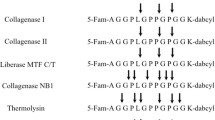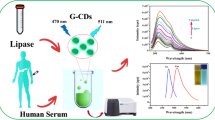Abstract
In this study, a fluorescence detection strategy is reported for the peptidase activity assay, which is based on fluorescence resonance energy transfer (FRET) from a fluorophore-labelled peptide to graphene oxide (GO). By the hydrolysis of the peptide, the fluorophore-labelled peptide releases the fluorophore 5-carboxyfluorescein, which can avoid quenching from GO. Thus, the increased intensity of the obtained fluorescence signal in the assay is directly dependent on the peptidase activity. As a model case of the developed strategy, the activity determination of pancreatic elastase (PE) is performed. Under the optimal experimental conditions at an excitation wavelength of 494 nm, the activity of PE can be determined in the range from 0.003 to 0.10 U/mL, with a detection limit of 0.001 U/mL at the emission wavelength of 518 nm. This is ultra-sensitive for the determination of PE. The specificity of the method is demonstrated by the analysis of PE under complex conditions using fetal bovine serum as the substrate. Hence, the developed method might provide an intrinsically convenient, sensitive platform for the PE activity assay and related biochemical studies due to its homogeneous, and fluorescence-based detection strategy.






Similar content being viewed by others
References
Paetzel M, Karla A, Strynadka NCJ, Dalbey RE (2002) Signal peptidases. Chem Rev 102:4549–4579. https://doi.org/10.1021/cr010166y
Bowerman B, Kurz T (2006) Degrade to create: developmental requirements for ubiquitin-mediated proteolysis during early C. elegans embryogenesis. Development 133:773–784. https://doi.org/10.1242/dev.02276
Saboo A, Rathnayake A, Vangaveti VN, Malabu UH (2016) Wound healing effects of dipeptidyl peptidase-4 inhibitors: an emerging concept in management of diabetic foot ulcer—a review. Diabetes Metab Syndr 10:113–119. https://doi.org/10.1016/j.dsx.2015.04.006
Mele DA, Bista P, Baez DV, Huber BT (2009) Dipeptidyl peptidase 2 is an essential survival factor in the regulation of cell quiescence. Cell Cycle 8:2425–2434. https://doi.org/10.4161/cc.8.15.9144
Matheeussen V, Waumans Y, Martinet W, Goethem SV, Veken PV, Scharpe S, Augustyns K, De Meyer GRY, De Meester I (2013) Dipeptidyl peptidases in atherosclerosis: expression and role in macrophage differentiation, activation and apoptosis. Basic Res Cardiol 108:350. https://doi.org/10.1007/s00395-013-0350-4
Xie W, Liu XX, Song ZJ (2018) Impact of dipeptidyl-peptidase 4 inhibitors on cardiovascular diseases. Vascul Pharmacol 109:17–26. https://doi.org/10.1016/j.vph.2018.05.010
Nalivaeva NN, Belyaev ND, Zhuravin IA, Turner AJ (2012) The Alzheimer’s amyloid-degrading peptidase, neprilysin: can we control it? Int J Alzheimer’s Dis. https://doi.org/10.1155/2012/383796
Shah Z, Kampfrath T, Deiuliis JA, Zhong J, Pineda C, Ying Z, Xu X, Lu B, Moffatt-Bruce S, Durairaj R, Sun Q, Mihai G, Maiseyeu A, Rajagopala S (2011) Long-term dipeptidyl-peptidase 4 inhibition reduces atherosclerosis and inflammation via effects on monocyte recruitment and chemotaxis. Circulation 124:2338–2349. https://doi.org/10.1161/CIRCULATIONAHA.111.041418
Morimoto C, Lord CI, Zhang C, Duke-Cohan JS, Letvin NL, Schlossman SF (1994) Role of CD26/dipeptidyl peptidase IV in human immunodeficiency virus type 1 infection and apoptosis. PNAS 91:9960–9964. https://doi.org/10.1073/pnas.91.21.9960
Fadini GP, Boscaro E, Albiero M, Menegazzo L, Frison V, de Kreutzenberg S, Agostini C, Tiengo A, Avogaro A (2010) The oral dipeptidyl peptidase-4 inhibitor sitagliptin increases circulating endothelial progenitor cells in patients with type 2 diabetes. Diabetes Care 33:1607–1609. https://doi.org/10.2337/dc10-0187
Yang P, Bamlet WR, Sun Z, Ebbert JO, Aubry MC, Taylor WR, Marks RS, Deschamps C, Swensen SJ, Wieben ED, Cunningham JM, Melton LJ, de Andrade M (2005) α1-Antitrypsin and neutrophil elastase imbalance and lung cancer risk. Chest 128:445–452. https://doi.org/10.1378/chest.128.1.445
Young MJ, Hsu KC, Lin TE, Chang WC, Hung JJ (2019) The role of ubiquitin-specific peptidases in cancer progression. J Biomed Sci 26:42. https://doi.org/10.1186/s12929-019-0522-0
Schlüter H, Hildebrand D, Gallin C, Schulz A, Thiemann J, Trusch M (2008) Mass spectrometry for monitoring protease reactions. Anal Bioanal Chem 392:783–792. https://doi.org/10.1007/s00216-008-2213-7
O’Donoghue AJ, Eroy-Reveles AA, Knudsen GM, Ingram J, Zhou M, Statnekov JB, Greninger AL, Hostetter DR, Qu G, Maltby DA, Anderson MO, DeRisi JL, McKerrow JH, Burlingame AL, Craik CS (2012) Global identification of peptidase specificity by multiplex substrate profiling. Nat Methods 9:1095–1100. https://doi.org/10.1038/nmeth.2182
Erickson JA, Aldeen WE, Grenache DG, Ashwood ER (2008) Evaluation of a fecal pancreatic elastase-1 enzyme-linked immunosorbent assay: assessment versus an established assay and implication in classifying pancreatic function. Clin Chim Acta 397:87–89. https://doi.org/10.1016/j.cca.2008.07.022
Weiss FU, Budde C, Lerch MM (2016) Specificity of a polyclonal fecal elastase ELISA for CELA3. PLoS ONE 11:e0159363. https://doi.org/10.1371/journal.pone.0159363
Aldewachi HS, Woodroofe N, Turega S, Gardiner PHE (2017) Optimization of gold nanoparticle-based real-time colorimetric assay of dipeptidyl peptidase IV activity. Talanta 169:233–238. https://doi.org/10.1016/j.talanta.2017.03.039
Le DV, Nguyen VT, Tang LJ, Jiang JH, Yu RQ, Wang YZ (2013) Proteolysis-mediated protection of gold nanoparticles for sensitive activity assay of peptidases. Talanta 107:2363–2371. https://doi.org/10.1016/j.talanta.2013.01.016
Ionescu RE, Cosnier S, Marks RS (2006) Protease amperometric sensor. Anal Chem 78:6327–6331. https://doi.org/10.1021/ac060253w
Edwards JV, Prevost NT, French AD, Concha M, Condon BD (2015) Kinetic and structural analysis of fluorescent peptides on cotton cellulose nanocrystals as elastase sensors. Carbohyd Polym 116:278–285. https://doi.org/10.1016/j.carbpol.2014.04.067
Kumaraswamy T, Bergstedt Shi X, Rininsland F, Kushon S, Xia W, Ley K, Achyuthan K, McBranch D, Whitten D (2004) Fluorescent-conjugated polymer superquenching facilitates highly sensitive detection of proteases. PNAS 101:7511–7515. https://doi.org/10.1073/pnas.0402367101
Falkovsky LA (2008) Optical properties of graphene. J Phys 129:0120041
Kampouris DK, Banks CE (2010) Exploring the physicoelectrochemical properties of graphene. Chem Commun 46:8986–8988. https://doi.org/10.1039/C0CC02860F
Eckhart KE, Holt BD, Laurencin MG, Sydlik SA (2019) Covalent conjugation of bioactive peptides to graphene oxide for biomedical applications. Biomater Sci 7:3876–3885. https://doi.org/10.1039/C9BM00867E
Smith AT, LaChance AM, Zeng S, Liu B, Sun L (2019) Synthesis, properties, and applications of graphene oxide/reduced graphene oxide and their nanocomposites. Nano Mater Sci 1:31–47. https://doi.org/10.1016/j.nanoms.2019.02.004
Wu X, Mu F, Wang Y, Zhao H (2018) Graphene and graphene-based nanomaterials for DNA detection: a review. ACS Nano Mol 23:2050. https://doi.org/10.3390/molecules23082050
Cheng X, Cen Y, Xu G, Wei F, Shi M, Xu X, Sohail M, Hu Q (2018) Aptamer based fluorometric determination of ATP by exploiting the FRET between carbon dots and graphene oxide. Microchimca Acta 185:144. https://doi.org/10.1007/s00604-018-2683-z
Zhang M, Yin BC, Wang XF, Ye BC (2011) Interaction of peptides with graphene oxide and its application for real-time monitoring of protease activity. Chem Commun 47:2399–2401. https://doi.org/10.1039/C0CC04887A
Le DV, Jiang JH (2020) Fluorescence determination of the activity of O6-methylguanine-DNA methyltransferase based on the activation of restriction endonuclease and the use of graphene oxide. Microchimica Acta 187:300. https://doi.org/10.1007/s00604-020-04280-0
Shi H, Zhang B, Liu S, Tan C, Tan Y, Jiang Y (2018) A new strategy involving the use of peptides and graphene oxide for fluorescence turn-on detection of proteins. Sensors 18:385. https://doi.org/10.3390/s18020385
Li SH, Aphale AN, Macwan IG, Patra PK, Gonzalez WG, Miksovska J, Leblanc RM (2012) Graphene oxide as a quencher for fluorescent assay of amino acids, peptides, and proteins. ACS Appl Mater Interfaces 4:7069–7075. https://doi.org/10.1021/am302704a
Povedailo VA, Ronishenko BV, Stepuro VI, Tsybulsky DA, Shmanai VV, Yakovlev DL (2018) Fluorescence quenching of dyes by graphene oxide. J Appl Spectrosc 85(4):605–610. https://doi.org/10.1007/s10812-018-0693-6
Harper JW, Cook RR, Roberts CJ, McLaughlin BJ, Powers JC (1984) Active site mapping of the serine proteases human leukocyte elastase, cathepsin G, porcine pancreatic elastase, rat mast cell proteases I and II, bovine chymotrypsin A, and staphylococcus aureus protease V-8 using tripeptide thiobenzyl ester substrated. Biochemistry 23:2995–3002. https://doi.org/10.1021/bi00308a023
Bieth JG, Dirrig S, Jung ML, Boudier JC, Papamichae E, Sakarellos C, Dimicoli JL (1989) Investigation of the active center of rat pancreatic elastase. Biochem Biophys Acta 994:64–74. https://doi.org/10.1016/0167-4838(89)90063-0
Hummers WS Jr, Richard EO (1958) Preparation of graphitic oxide. J Am Chem Soc 80:1339–1339. https://doi.org/10.1021/ja01539a017
Tang L, Feng H, Cheng J, Li J (2010) Uniform and rich-wrinkled electrophoretic deposited graphene film: a robust electrochemical platform for TNT sensing. Chem Commun 46:5882–5884. https://doi.org/10.1039/c0cc01212b
Song E, Cheng D, Song Y, Jiang M, Yu J, Wang Y (2013) A graphene oxide-based FRET sensor for rapid and sensitive detection of matrix metalloproteinase 2 in human serum sample. Biosens Bioelectron 47:445–450. https://doi.org/10.1016/j.bios.2013.03.030
Xu W, Xie ZH, Tong CY, Peng L, Xiao CH, Liu XM, Zhu YH, Liu B (2016) A rapid and sensitive method for kinetic study and activity assay of DNase I in vitro based on a GO-quenched hairpin probe. Anal Bioanal Chem 408:3801–3809. https://doi.org/10.1007/s00216-016-9474-3
Acknowledgements
This work was financial supported by the Industrial University of Ho Chi Minh City. The author gratefully thanks Mr. Van-Hiep Dinh at the Center of Analytical Services and Experimental HCMC for facilities supports.
Author information
Authors and Affiliations
Corresponding author
Ethics declarations
Conflict of interest
The author declare that they have no conflict of interest.
Informed Consent
This article does not contain any studies involving human participants.
Research Involving Human Participants and/or Animal
This article does not contain any studies with human participants or animals.
Additional information
Publisher's Note
Springer Nature remains neutral with regard to jurisdictional claims in published maps and institutional affiliations.
Supplementary Information
Below is the link to the electronic supplementary material.
Rights and permissions
About this article
Cite this article
Le, DV. Fluorescence Determination of Peptidase Activity Based on the Quenching of a Fluorophore-Labelled Peptide by Graphene Oxide. Protein J 40, 682–688 (2021). https://doi.org/10.1007/s10930-021-09985-6
Accepted:
Published:
Issue Date:
DOI: https://doi.org/10.1007/s10930-021-09985-6




